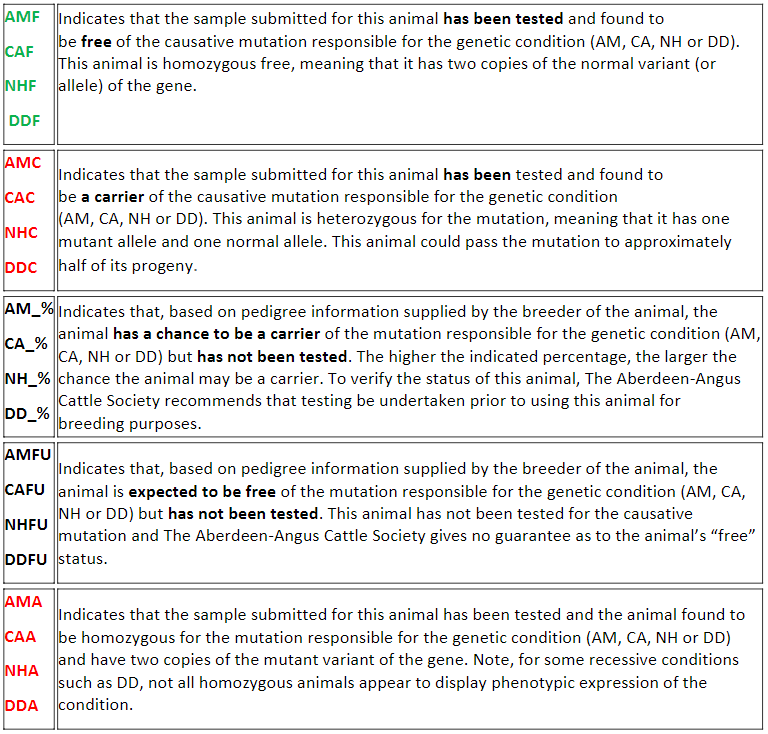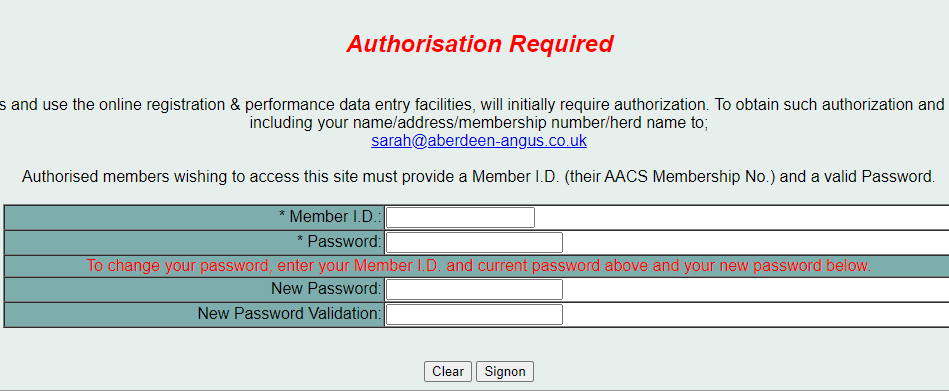Managing Genetic Conditions
A genetic condition is caused by an abnormality in an individual’s DNA. These abnormalities can range from a single gene mutation to the addition or loss of an entire chromosome.
Genetic conditions have been identified in most species, including humans, and more than 400 genetic conditions have been identified in beef cattle. Approximately one quarter of these conditions are caused by a single gene mutation, making them easy to manage through DNA testing.
Historically, before DNA tests were available, genetic conditions were managed by extensive progeny testing or by eradicating all known relatives of the affected animal. This resulted in production losses and the potential loss of superior genetics.
Developments in DNA testing and gene probability technology now allow breeders to more easily identify carriers of genetic conditions and manage it such that production losses and
spread of the mutation can be minimised.
How do I identify an animal with a genetic condition?
The physical expression of genetic conditions can vary significantly. When large numbers ofcalves are dying or being born with similar abnormalities, both environmental and genetic
causes are suspected. Consequently, there is a need for the surveillance and reporting of abnormal calves to breed societies, vets or beef technical officers if genetic conditions are to be identified. Photographs and DNA samples from affected animals should be collected to aid in the identification of the condition.
How are genetic conditions inherited?
Genetic conditions have different modes of inheritance. Many have a simple recessive inheritance of a single gene mutation making them easy to manage. These single gene recessive genetic conditions result in three possible genotypes:
1. Free – animal is normal and carries two copies of the normal form and no copies of the mutation
2. Affected – affected or abnormal animal which carries two copies of the mutation
3. Carrier – animal which looks normal, but carries one copy of the mutation which can be passed onto offspring
This diagram provides an illustration of the possible mating outcomes from different mating combinations for a single gene recessive genetic condition.

Tools Available to Manage Genetic Conditions
Developments in DNA technology have resulted in diagnostic tests being available for several single gene recessive genetic conditions. The ability for breeders to collect a DNA sample (hair, semen, blood or tissue) and send it to The Aberdeen-Angus Cattle Society for testing has significantly assisted the management of genetic conditions.
The Aberdeen-Angus Cattle Society uses GeneProb software to calculate the probability of an animal being a carrier of genetic conditions such as AM, NH, CA, and DD.
Managing Genetic Conditions
There is no ‘one size fits all’ strategy for managing genetic conditions. Before embarking on a management strategy breeders should consider,
- The economic impact of the condition
- The frequency of the condition within the herd and/or breed
- The availability and cost of DNA tests
- Researching the genetic condition status of any animals being brought into the herd
- Legal obligations about disclosing the carrier status of sale animals
- The Aberdeen-Angus Cattle Society regulations
Generally, the management of genetic conditions can be broken into two components,
- Managing the Incidence of Affected Animals
In simple terms, the incidence of animals affected by the genetic condition can be managed by avoiding mating carrier cows to a carrier bull. This may be relatively easy to manage in pedigree herds, but can be extremely difficult in commercial herds where limited pedigree records are kept. For this reason it is recommended pedigree or commercial herds should use the Aberdeen-Angus Cattle Society animal search facility to determine the GeneProb status of bulls they used. This will help to determine the level of risk in the herd for the particular genetic condition.
2. Managing the Incidence of Carriers
Managing the frequency of carrier animals is important in pedigree herds. Where available, the use of DNA testing to determine if an animal is either free or a carrier for a genetic condition broadens the options for breeders looking to manage or eradicate the mutation. Use of software like GeneProb to calculate the risk of particular untested individuals being carriers enables DNA testing efforts to focus on high risk animals.
Breeders should carefully consider and develop a management strategy that will be used to manage each genetic condition. Some examples of management strategies are as follows:
- Conduct strategic DNA testing of highly influential animals (eg, sires, donor dams, prominent dams) to calculate the probability of animals being carriers, and better identify the “at risk” bloodlines. Further testing can then be conducted to better isolate the carriers present in the herd.
- DNA test at risk animals in the breeding herd to identify carrier animals. Rather than being sold, carrier females can be retained for use as recipient dams in embryo transfer programs.
- Continue to use carrier animals in the breeding program by mating them only to tested free sires/dams and testing the progeny. As outlined previously, mating a carrier to a free animal will results in 100% of calves being unaffected by the genetic condition, with 50% of the resulting offspring being free of the condition and 50% being carriers. This approach is of particular benefit when the carrier animal is of high genetic merit and the producer wants to utilise these desirable genes in the breeding program.
- Only use sires that are tested free or expected to be free by inheritance to ensure the incidence of the condition does not increase. This is a common approach for genetic conditions of low economic impact.
In all situations, if carrier animals are sold, full disclosure of their genetic condition status should be provided.
Genetic Test Codes
The genetic condition status of Aberdeen-Angus animals is routinely displayed for the following genetic conditions:
- Arthrogryposis Multiplex (AM)
- Contractual Arachnodactyly (CA)
- Neuropathic Hydrocephalus (NH)
- Development Duplications (DD)
An animals genetic condition status in based on DNA samples provided by breeders.
Disclaimer: The Aberdeen-Angus Cattle Society makes no statements, representations or warranties about the accuracy or completeness of any information relating to the status of a particular animal; and, disclaims all responsibility for information and all liability (including without limitation, liability in negligence) for all expenses, losses, damages, and costs you may incur as a result of information being inaccurate or incomplete in any way for any reason.
Description of the Genetic Test Codes

Downloading Genetic Conditions Results File
Below is a simple set of instructions for downloading and opening a genetic condition result file.
- Go to www.aberdeen-angus.co.uk
- On top right hand side of home page click online database




In the file name field located the GeneProb files available as a PDF or CSV file.

The PDF File lists the % probability of animals in your herd for that particular defect.
You will be given the option to save or sort CSV file. Once open your animal idents will be listed in column E and their genetic defects listed in column L. You may need to expand columns in order to see the full header. You can then sort these listings in excel.
If you are experiencing any difficulty in accessing downloads or wish any further explanation on genetic defects please contact [email protected]
